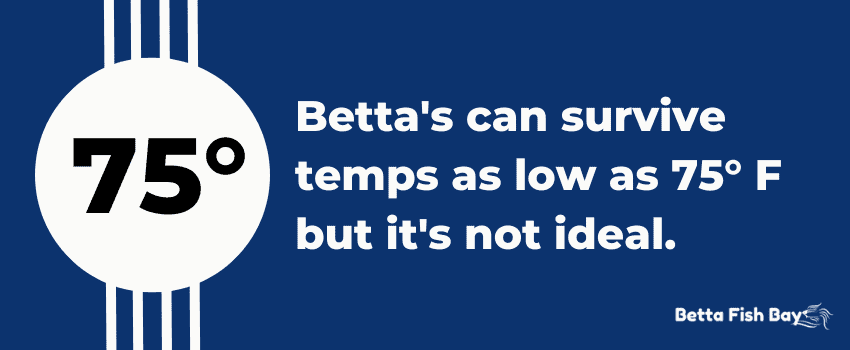Wild betta fish live in the tropical climate of Southeast Asia, where the shallow waters are around 80° degrees Fahrenheit (27° C).
Recreating the tropical temperatures of a betta’s natural environment is challenging, especially for inexperienced fish keepers.
But why is the water temperature for a betta fish so important?
Betta fish rely on warmer waters of 78-80° degrees Fahrenheit (27° C) to maintain their metabolism rate and immune system health. Extremely hot or cold water causes temperature shock in bettas. Exposure to temperatures outside of the ideal range for extended periods can kill a betta fish.

Table of Contents
Optimal Temperature Range for a Betta Fish
The ideal temperature for betta fish ranges from 78-80° degrees Fahrenheit (27° C).
Temperatures below 70° degrees Fahrenheit (21° C) and above 84° degrees Fahrenheit (29° C) are fatal for betta fish.
Maintaining consistency within the ideal temperature range is crucial to your betta’s quality of life.
Sudden fluctuations in temperature have a detrimental effect on a betta’s health.
A couple of situations put your tank at a higher risk for temperature changes.
During Water Changes
The highest risk of temperature shock occurs during water changes.
You must ensure the new water you add to the betta tank is heated to the same temperature as the water inside the tank.
Room temperature water is usually not warm enough for your betta tank.
Fill your bucket with warm water and check it with a thermometer. Ensure the temperature is as close to 80° degrees Fahrenheit (27° C) as possible.
Adding the new water slowly also prevents sudden temperature shifts in the tank.
Introducing Your Betta to a New Tank
Take it slow when introducing a betta fish to a new tank.
The temperature in your new betta’s container is not likely the same as the tank you prepared.
A slow introduction into the new tank is crucial for preventing temperature shock.
Can Betta Fish Survive in Colder Water Temperatures?

Betta fish can survive in temperatures as low as 75° degrees Fahrenheit (24° C), but it is not ideal for their health.
When the tank water is below the ideal temperature range of 78-80° degrees Fahrenheit (27° C), your betta is not thriving.
Cold temperatures influence a betta’s bodily functions and behavior.
When aquarium temperatures drop, so does your betta’s metabolism rate. This slows digestion and causes bloating and constipation.
As a result, your betta loses its appetite and becomes lethargic. You may notice your betta is pale and spends a lot of time at the bottom of the tank.
Bloating and constipation may even lead to a deadly disease called dropsy. Dropsy causes fluid buildup and organ failure in bettas and is usually fatal.
Another side effect of cold water is a lowered immune system. Your betta becomes weak and has a lower immunity to diseases and infections.
Cold water also contains less oxygen. You may notice rapid gill movement as your betta struggles with breathing.
Once temperatures drop below 70° degrees Fahrenheit (21° C), your betta can die within a few hours.
Best Way To Measure Betta Fish Temperature
Most aquarium heaters have built-in thermometers. But, these temperature readings are not always accurate.
The design of many aquarium heaters places the heating element underneath the thermostat.
Temperature readings on aquarium heaters may vary up to three degrees!
Three degrees does not seem like much to us, but this is a significant temperature variance to your betta.
Place a separate thermometer on the opposite side of the tank for a more accurate temperature reading.
Use a high-quality filter for better water circulation. This ensures there are no hot or cold spots in the tank.
When shopping for an aquarium thermometer, there are several features you must look for:
- Accuracy
- Readability
- Durability
- Placement
The most accurate type of thermometer is the traditional glass type.
Digital thermometers are usually easier to read but do not always show the correct temperature reading.
Avoid the stick-on thermometers included with most aquarium kits. They stick onto the outside of the tank and are highly inaccurate.
Stick-on thermometers also lack durability. Most of them fail within one year.
Floating thermometers and the ones you stick into the substrate may seem like a good idea. However, placement is difficult, and readability is low.
This submersible thermometer ticks all the boxes and is the one we recommend.
It attaches to the tank with a magnet instead of a suction cup for easy placement. The thermometer also features a durable design with large, easy-to-read numbers and superior accuracy.
Factors Affecting Betta Tank Temperature

Besides water changes, several factors affect betta fish tank temperatures, including:
- Tank size
- Tank location
- Heater capabilities
Tank Size
Maintaining a larger betta tank is much easier than a small one.
A 10- or 20-gallon tank retains more heat than a 5-gallon tank. Water temperatures in larger tanks are also more consistent.
Heating a smaller tank is challenging because you risk overheating it. Smaller tanks are also prone to temperature fluctuations due to heat loss.
Tank Location
The placement of your betta tank is vital for maintaining temperatures.
Tank temperatures are usually cooler than the ambient temperature of the room.
The average room temperature ranges from 68-72° degrees Fahrenheit (22° C). This is nowhere near the 78-80° degree Fahrenheit (27° C) temperatures a betta fish needs.
Keep your betta tank away from windows and air conditioning vents.
Sunlight from nearby windows can raise your tank temperatures too much in a short period. If you live in a cold climate, cool drafts may also cause issues.
Heating and air conditioning vents cause significant temperature fluctuations when they blow air over your betta tank. Be aware of the vent placement in the room when scouting a location for your aquarium.
Heater Capabilities
Ensure your heater has the recommended wattage output for your tank size.
A 25-watt heater works well in a 5-gallon tank but struggles to heat a 10 or 20-gallon tank. Likewise, a 50-watt heater may cause sudden temperature fluctuations in a 5-gallon tank.
As a general rule of thumb, your heater output must range from 3 to 5 watts for every gallon of water in the tank.
11 Signs Of Temperature-Related Stress In Bettas
Temperature shock symptoms vary depending on what your betta fish is exposed to.
Cold temperature shock symptoms in bettas include:
- Lethargy
- Resting at the bottom of the tank
- Pale color
- Bloating/Constipation
- Illness
- Rapid gill movement
- Loss of appetite
Hot water temperature shock has a different set of symptoms, such as:
- Staying at the surface
- Gasping for air
- Erratic swimming
- Brighter color
In both cases, your betta fish is fighting to stay alive. You must take action and reverse the effects before it is too late.
If your betta is exposed to cold temperatures for an extended period, it may fall into a coma. Once you warm the water, your betta should become active again.
It only takes a few hours of exposure to extreme water temperatures before your betta dies.
How To Safely Raise or Lower the Temperature of a Betta Tank

If your betta is in temperature shock, it is very dangerous.
Any changes you make to the tank temperature must be done gradually. Raising or lowering temperatures too quickly puts your betta’s health at an even greater risk.
Check temperatures with a thermometer throughout the process. This ensures you are not raising or lowering them too much.
Stop the process once the tank reaches the ideal water temperature.
What To Do if Tank Temperatures Are Too Low
Cold water temperatures are more common than hot water temperatures. Knowing what to do can save your betta’s life.
First, check your heater for any malfunctions. Even high-quality heaters break down from time to time.
If your heater works, increase the temperature. Check the water with a separate thermometer to know it is not too hot.
Move your betta tank away from any windows or air vents.
You may also increase temperatures by filling a plastic bag with hot water and floating it in your tank for a few minutes.
What To Do if Tank Temperatures Are Too High
Your betta tank may overheat from a malfunctioning heater or direct sunlight.
If your tank heater is on, turn it off. Move your betta tank away from a sunny window or other heat sources.
Turn off the tank lights, as they may produce heat.
Blow a fan across the surface of the water. This moves cooler air into the tank and helps evaporate the hot water.
Perform a 5-10% water change. This is the fastest way of cooling down the tank water.

Do not remove too much water or risk cooling it down too quickly for your betta.
Place a clean frozen water bottle inside the tank if everything else fails. Only do this for a few minutes at a time and check the temperature of the water frequently.
You may also want to add an air bubbler for oxygen circulation.
Hot water does not contain as much oxygen as cold water. This may cause suffocation in your betta fish.
Is a Heater Necessary in a Betta Fish Tank?
Bettas are tropical fish, and an aquarium heater is needed to maintain tank temperatures.
Constant temperatures are essential for sustaining a healthy environment.
Clip-on or submersible heaters are the best choices for a betta tank.
In-line heaters are usually too powerful for betta tanks. These heaters are mostly used in aquariums larger than 50 gallons.
Avoid flatbed or substrate heaters. They are known for being unreliable and dangerous.
You must consider several factors when choosing a heater for your betta tank.
And for emergencies, read our post on keeping betta fish warm without a heater.
Watts to Tank Size
The heater you choose must be powerful enough to heat your betta tank evenly.
Your heater should provide 3 to 5 watts for every gallon of water.
If you have a 10-gallon tank, you need a heater with 30-50 watts of power.
You may also use two smaller heaters on opposite ends of the tank. This allows for more even heating throughout the tank.
For a 10-gallon tank, two heaters ranging from 15-25 watts are acceptable.
Adjustability
Not all betta tank heaters are adjustable.
Many cheap heaters only heat the water to a preset temperature before shutting off.
An adjustable heater allows you to raise or lower temperatures depending on the ambient room temperature.
If you use your home’s air conditioning a lot during the summer, the temperature of your aquarium heater may need an increase.
Readability
An easy-to-read temperature scale makes adjusting your heater less difficult.
Since most aquarium heaters have unreliable thermostats, use a separate thermometer for checking tank temperatures.
The water closest to the heater may be warmer than the water on the opposite side of the tank.
A good filtration system circulates the water for more even heating.
Safety Features
Ensure your heater is fully submersible. If it is not, you risk electrocuting yourself or your betta.
Look for a heater with an automatic shut-off feature as well. This safety feature turns the heater off if water levels get too low.
A safety guard is also an important feature. The safety guard prevents your betta from coming into contact with the heating elements and getting burned.
We recommend this heater for its safety features, accuracy, and ease of use.
Can Betta Fish Adapt to Different Temperature Ranges?

There are special considerations when introducing your betta to its new tank.
A slow introduction is the safest way of preventing temperature shock in your new fish.
First, remove water from your betta container and gradually replace it with tank water. This prevents contaminating your tank with whatever is in the water at the pet store.
Once your betta’s container is filled with tank water, float the container in the tank for several minutes. This warms the container to the same temperatures as the tank.
It may take 15-20 minutes for your betta to acclimate to the new temperature.
After the water inside the container is warm, scoop your betta out with a small net and release it into its new home.
It is time-consuming, but it significantly decreases the chance of temperature shock.
Do Betta Sororities Have Special Temperature Needs?
Never house two male bettas together, but several female bettas can live comfortably in the same tank.
The tank must be at least 20 gallons because betta sororities need at least five fish. This number of fish prevents bullying among females.
Betta sororities do not have any special temperature requirements. They are comfortable in the same betta fish temperature range of 78-80° degrees Fahrenheit (27° C).
If you house a betta sorority in a 30-gallon tank or larger, you may consider adding a second heater.
A second heater ensures all the water in a large tank is heated at the same temperature. It also prevents sudden fluctuations in water temperature in a larger tank.
How Do I Maintain a Consistent Temperature in My Betta Tank?
Stable betta tank temperatures are not difficult to accomplish with a little effort.
The most important thing is checking tank temperatures daily. This allows you to make slight changes before they become an issue.
Invest in a reliable heater, and get two if you have concerns about evenly heating your betta tank. Two heaters also give you some wiggle room if one of the heaters breaks down.
Most importantly, keep your betta tank away from sunny windows, drafts, and air vents.
Keeping It Real (Warm) for Your Bettas
Betta fish thrive in a temperature range of 78-80° degrees Fahrenheit (27° C).
Maintaining betta fish water temperatures is not difficult if you have the right tools.
Invest in an accurate thermometer and a reliable fish tank heater to ensure your betta’s comfort.
Understand the signs of temperature shock in bettas, so you know what to do if it happens.
To learn more about betta fish water parameters, check out our article on maintaining water quality in a betta tank.


